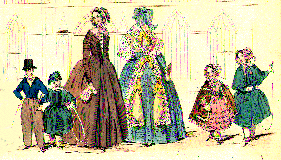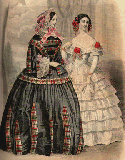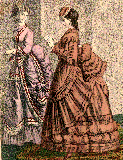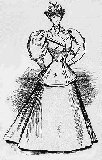


After 1815 women's dress became increasingly fussy and decorative, as skirts became
fuller, and the waistline gradually descended to the natural waist. Severe corseting also
returned, as did layers of petticoats. In this period, women were pushed back into a more
modest role, befitting the "weaker" sex, often described as delicate, fragile, and decorative.
The intellectuals and artists of the
Romantic movement valued emotion and sentiment, in contrast to the cold reason that was
perceived to have driven the revolutions of the 18th century enlightenment. Women, believed
to be more emotional than men, were idealized as the muses of artists. Some, like
Elizabeth Barret Browning and Mary Shelley, achieved recognition as artists in their own right. Women were also placed on a moral pedestal, and looked upon as the guardians of family and
community virtue, and the educators of the children. This moral
elevation of women would eventually lead some to suggest that women deserved a wider role
in public affairs. However, for now, dress reflected the perception of women as weak and
decorative. The slope-shouldered, full sleeved silhouette suggested a weak body, and a butterfly-like decorative quality. Later in the period, the look became increasingly subdued and modest.

The young queen Victoria came to the throne in 1837, and would rule England
until 1901 during the height of the British Empire. During this period she became
a happily married mother of nine children, and represented the ideal of womanhood
for her age-- modest, devoted to family and duty, and the guardian of morality.
Her tastes in clothing were also influential, reflecting her values, and those
of her times.  The major characteristic of the dress silhouette in this period was the
exceptionally
full and long skirts that completely shrouded the lower body . The skirts
became so full that by the late 1850's hoops were needed to support the skirts,
as the heavy layers of petticoats could no longer achieve the desired effect.
The bodice and shoulders were very narrow, accentuating a weak upper body silhouette
and tiny waist accentuated by the voluminous skirts. In the 1840s and 1850s
deep bonnets were worn that modestly hid the face and neck except when the wearer
looked directly at the viewer (above, right). In fact, except for evening wear,
clothing covered virtually every bit of skin except the face (left). However,
it was also in this period that the first protests against this restrictive
form of dress appeared.
Dress reform was associated with concern for protecting
the health and welfare of women, which included the women's suffrage movement
and the temperance movement. The restrictive fashionalble dress of the day was
seen as both unhealthy and as a restriction on women's activities. An alternative
costume was promoted that was based on loose-fitting pants borrowed from
traditional
Turkish women's costume. This costume became known as
Bloomers, because
it was popularly associated with activist and editor Amelia Jenks Bloomer. However,
this costume was not widely accepted at the time for street wear, although bloomers
were gradually adopted for girl's and women's physical education activities.
The major characteristic of the dress silhouette in this period was the
exceptionally
full and long skirts that completely shrouded the lower body . The skirts
became so full that by the late 1850's hoops were needed to support the skirts,
as the heavy layers of petticoats could no longer achieve the desired effect.
The bodice and shoulders were very narrow, accentuating a weak upper body silhouette
and tiny waist accentuated by the voluminous skirts. In the 1840s and 1850s
deep bonnets were worn that modestly hid the face and neck except when the wearer
looked directly at the viewer (above, right). In fact, except for evening wear,
clothing covered virtually every bit of skin except the face (left). However,
it was also in this period that the first protests against this restrictive
form of dress appeared.
Dress reform was associated with concern for protecting
the health and welfare of women, which included the women's suffrage movement
and the temperance movement. The restrictive fashionalble dress of the day was
seen as both unhealthy and as a restriction on women's activities. An alternative
costume was promoted that was based on loose-fitting pants borrowed from
traditional
Turkish women's costume. This costume became known as
Bloomers, because
it was popularly associated with activist and editor Amelia Jenks Bloomer. However,
this costume was not widely accepted at the time for street wear, although bloomers
were gradually adopted for girl's and women's physical education activities.
In the 1860's, though skirts reached their fullest, hats became smaller.Decoration became more geometric, and striped fabrics were also popular. By the end of the period, the full skirts became asymmetrical, with fullness pushed to the back, a precursor of the next major fashion shift.
In this period the sewing machine was invented, revolutionizing the manufacture of clothing. By the mid 1850s sewing machines were appearing in private homes, and began to account for a substantial proportion of domestic clothing production. This invention also made possible the rise of the ready-to-wear clothing industry.
Charles Frederick Worth became established in Paris in this period as the first true couturier-- that is the first dressmaker who would set fashion, not merely follow the instructions of his wealthy clients. His premier client was the French Empress Eugenie. By the 1870s the well-to- do women of the world came to his salon to be dressed by the great Worth.

After the death of her husband in 1861, Victoria went into seclusion, and though still deeply respected as sovereign of a great empire, she ceased to influence fashion as directly. The somber colors that came into fashion are attributed to the fact that the British Court remained in mourning. Black became a popular fashion color in this period, not only worn for mourning. However dress forms changed significantly. After decades of full skirts, a new silhouette appeared that accentuated the body while still covering it. The tightly fitted bodice remained, but now the full skirts were swept back, leaving a tight narrow skirt in the front, with all the fullness arranged in the back. The chief feature of this period was the rear emphasis in dress, typified by the bustle, a padded arrangement of drapery that accentuated the buttocks. The bustle was at its largest in the mid 1870s (above right), but would develop in a more tailored form in the mid 1880s (left). However, throughout the period, the narrow silhouette and rear emphasis was a constant.
 Although the new look was decried as immodest because it revealed, even exaggerated
the female shape, it was also an extremely restricting style that required exceptionally
severe corseting. This was a period in which more women were coming out of the
home and into the community to participate in volunteer work and other public
activities. In this period the women's rights movement (which included suffrage,
protection for working women, and
dress reform) gained momentum. Both the revelation
of the woman's body and the protest against the restrictiveness of the garments
reflected the changing times. In addition to factory work, long done by poor
women, the typewriter and the sewing machine were now creating work opportunities
for middle class women who needed income. Since fashionable dress limited mobility,
changes in dress were called for to accommodate these new realities.
Although the new look was decried as immodest because it revealed, even exaggerated
the female shape, it was also an extremely restricting style that required exceptionally
severe corseting. This was a period in which more women were coming out of the
home and into the community to participate in volunteer work and other public
activities. In this period the women's rights movement (which included suffrage,
protection for working women, and
dress reform) gained momentum. Both the revelation
of the woman's body and the protest against the restrictiveness of the garments
reflected the changing times. In addition to factory work, long done by poor
women, the typewriter and the sewing machine were now creating work opportunities
for middle class women who needed income. Since fashionable dress limited mobility,
changes in dress were called for to accommodate these new realities.
The Art Nouveau silhouette,
particularly that of the 1890's,
in some ways echoed the look of the early Romantic period. The Full "leg-o-mutton"
sleeves and flared, moderately full skirts were similar (left). However, the
hour-glass figure with its erect posture, stiffly boned collar band, and high
shoulders suggested a more formidable image than the slope-shouldered "decorative
butterfly" of the 1820s and 1830s. Increasing numbers of young unmarried women
now worked in shops and offices, and housewives were often active in church
work and other community voluntary activities. Women also began to appear socially
 in public,
in public, in restaurants and even at the beach. Sportswear -specialized clothing for strenuous
activity- had begun to appear as early as the 1860s but in the 1890s the advent
of the bicycle put women into pants-- "bloomers"-- in public for the first time.
Tailored (but skirted) suits for women, similar to men's suits in cut, were
now part of every woman's wardrobe (right). A example of a
dress
by the House of Worth, beautifully shows the relationship of fashion design
to design in the other decorative arts in this period.
in restaurants and even at the beach. Sportswear -specialized clothing for strenuous
activity- had begun to appear as early as the 1860s but in the 1890s the advent
of the bicycle put women into pants-- "bloomers"-- in public for the first time.
Tailored (but skirted) suits for women, similar to men's suits in cut, were
now part of every woman's wardrobe (right). A example of a
dress
by the House of Worth, beautifully shows the relationship of fashion design
to design in the other decorative arts in this period.
 After 1900 the silhouette shifted to the "s" curve of the new corset style (left),
recommended by reformers as a healthier alternative to the hour-glass silhouette.
Soft, gauzy fabrics combined with lace became the style, and for special occasions,
lightweight white lacy cotton dresses were worn by every one. The sinuous lines
and soft materials and colors were consistent with the Art Nouveau style as we
have seen it in furnishings and architecture. These soft dresses, particularly
those worn near the end of the period, were also reminiscent of the "classical"
styles of the revolutionary period a century earlier. Suits and tailored dresses
also continued to be part of the daytime repetoire, however. On the whole, clothing
was becoming more relaxed as women's lives continued to expand.
After 1900 the silhouette shifted to the "s" curve of the new corset style (left),
recommended by reformers as a healthier alternative to the hour-glass silhouette.
Soft, gauzy fabrics combined with lace became the style, and for special occasions,
lightweight white lacy cotton dresses were worn by every one. The sinuous lines
and soft materials and colors were consistent with the Art Nouveau style as we
have seen it in furnishings and architecture. These soft dresses, particularly
those worn near the end of the period, were also reminiscent of the "classical"
styles of the revolutionary period a century earlier. Suits and tailored dresses
also continued to be part of the daytime repetoire, however. On the whole, clothing
was becoming more relaxed as women's lives continued to expand.  |